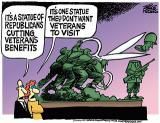Washington, D.C. — Aug 09, 2012 - The Army, along with the other military services and the Department of Veterans Affairs, is standardizing the diagnosis and treatment of post-traumatic stress disorder, known as PTSD.“No matter where Soldiers are getting care or seeking help for PTSD or any other medical issue, we want to ensure we are doing it the same way,” said Lt. Col. Christopher Warner, the Army Surgeon General’s psychiatric consultant and deputy commander, Clinical Services, Bassett Army Community Hospital, Fort Wainwright, Alaska.
Warner said standardization increases a Soldier’s level of trust and fairness in the system.
The Army medical community is now being trained on guidelines spelled out in Army Medical Command Policy Memo 12-035, “Policy Guidance on the Assessment and Treatment of Post-Traumatic Stress Disorder,” Warner said.
The memo, dated April 10, 2012, emphasizes the urgency of the issue.
“The majority of service members with PTSD do not seek treatment, and many who do seek treatment drop out before they can benefit,” the memo reads. “There are many reasons for this, including stigma, other barriers to care, and negative perceptions of mental health care. Lack of trust in military behavioral health professionals has been identified as one important predictor of service members not utilizing services. Therefore, it is critical that Army behavioral health professionals do everything they can to advocate for and provide care in a patient-centered manner that reassures patients that they will not be judged and that their primary concerns will be addressed.”
PTSD is a widespread problem. It occurs in 3-6 percent of service members with no deployment experience and in 5-25 percent of service members who have been deployed to combat zones. Combat frequency and intensity are the strongest predictors of the condition, according to the policy memo. read more>>>
























No comments:
Post a Comment